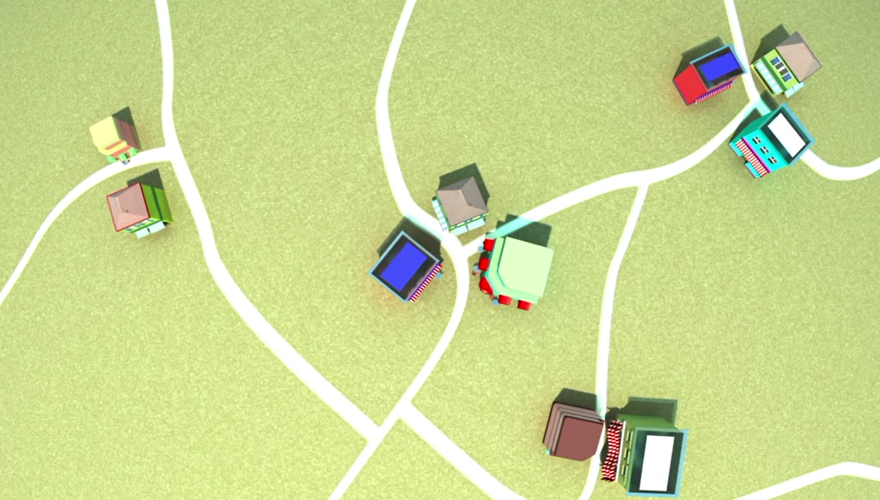Why are gas stations always built right next to other gas stations?
為什么加油站總是建在其他加油站旁邊?
Why is that I drive for a mile without finding a coffee shop and then stumble across three on the same corner?
為什么我們有時候會開了一英里卻找不到一家咖啡店?然后突然發(fā)現(xiàn)有3家咖啡店在同一個拐角?
Why do grocery stores, auto repair shops and restaurants always seem to exist in groups instead of being spread evenly throughout a community?
為什么雜貨店,汽車修理店和餐廳似乎總是聚在一起,而不是均勻地分布在整個區(qū)域?
While there are several factors that might go into deciding where to place your business, clusters of similar companies can be explained by a very simple story called Hotelling's Model of Spatial Competition.
雖然有多種因素可能會決定在哪里開店,但可以用一個簡單的故事來解釋為什么同類商店都聚在一起,這被稱為霍特林模型空間競爭。
Imagine that you sell ice cream at the beach.
想象一下你在海灘上賣冰淇淋。
Your beach is one mile long and you have no competition.
海灘長達一英里并且沒有任何競爭者。
Where would you place your cart in order to sell the most product?
你會把你的冰淇淋車放在哪里以賣出最多的產(chǎn)品?
In the middle.
在海灘中間。

The one-half-mile walk may be too far for some people at each end of the beach, but your cart serves as many people as possible.
對于在海灘兩端的某些人來說,他們最多只用走半英里,但你的冰淇淋車卻可以賣出最多的冰淇淋。
One day you show up at work just as your cousin Teddy is arriving at the beach with his own ice cream cart.
有一天你又來海灘賣冰淇淋,發(fā)現(xiàn)你的表兄弟泰迪帶著他的冰淇淋車也在賣冰淇淋。
In fact, he's selling exactly the same type of ice cream as you are.
并且,他賣的冰淇淋和你的一模一樣。
You agree that you will split the beach in half in order to ensure that customers don't have to walk too far you set up your cart a quarter mile south of the beach center, right in the middle of your territory.
為了讓客戶走的路程更短一些,你同意和他平分海灘。你把你的車放在距離海灘最南端1/4的地方,就在你地盤的中央。
Teddy sets up a quarter mile north of the center, in the middle of Teddy territory.
泰迪把它的冰淇淋車放在距離海灘北端1/4的地方,這是泰迪地盤的中央。
With this agreement, everyone south of you buys ice cream from you.
有了這個協(xié)議,在海灘南邊這些人都會來你這里買冰淇淋。
Everyone north of Teddy buys from him, and the 50% of beachgoers in between walk to the closest cart.
在北邊的那些人會從泰迪那里買冰淇淋。顧客都會去最近的冰淇淋車那里買。
No one walks more than a quarter of a mile, and both vendors sell to half of the beachgoers.
沒有人會走1/4英里以上的路程,你們各自供應(yīng)所有顧客所需冰淇淋的一半。
Game theorists consider this a socially optimal solution.
博弈論認為這是一個社會最優(yōu)的解決方案。
It minimizes the maximum number of steps any visitor must take in order to reach an ice cream cart.
它把顧客為了走到冰淇淋車所需的最長路程給縮小了。
The next day, when you arrive at work, Teddy has set up his cart in the middle of the beach.
第二天你剛開始賣冰淇淋的時候發(fā)現(xiàn)泰迪把他的冰淇淋車放在了海灘的中間。
You return to your location a quarter mile south of center and get the 25% of customers to the south of you.
你回到了海灘南端的中間并且只得到了25%的顧客。
Teddy still gets all of the customers north in Teddy territory, but now you split the 25% of people in between the two carts.
泰迪仍然獲得了他原先在海灘北端的顧客,但現(xiàn)在有25%的顧客處于兩部冰淇淋車的中間。



